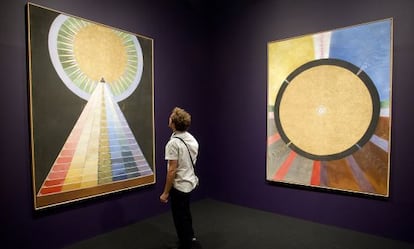Driven to abstraction
Remembering the woman who pioneered modern art

Being female and an artist in Europe at the turn of the last century wasn't easy. More so if you maintained that your work wasn't yours but produced by esoteric methods, such as trance states in which you created automatic drawings dictated from beyond. Neither was it easy to be a woman ahead of your time in a present that didn't understand you, a visionary artist omitted from contemporary canons.
That was the experience of Swedish artist Hilma af Klint (1862-1944), whose 200 works now on display at Málaga's Picasso Museum show she was producing abstract works before the men to whom the creation of the movement is attributed. Her condition as a woman artist, which was not well regarded during her time, and the fact she herself felt misunderstood, meant she remained largely anonymous for the best part of the 20th century, until in 1986 her work was exhibited in Los Angeles.
None of Klint's 1,000 or so works were ever exhibited in her lifetime. She left instructions in her will that nothing should be shown to the public until 20 years after her death as she thought no one would be able to understand them until then.
That wish, and the fact she wasn't well understood by her own family, who were religious and didn't agree with her esoteric practices, caused her work to remain forgotten for many years. "For my family she was like a black sheep," explains Johan af Klint, Hilma's grandnephew and president of the foundation that bears her name. "She wasn't much recognized for being an independent woman, with her own ideas. She donated all her work to my father, who found himself with an enormous problem as he didn't know what to do with her paintings."
Wassily Kandinsky is the artist normally attributed with the creation of the abstract movement with a work dated 1911, "but already in 1906 Hilma af Klint had fully immersed herself in that current," explains the exhibition's curator, Iris Müller-Westermann, standing in front of Klint's series Primordial Chaos (1906) and The Ten Biggest (1907), works in which, via chromatism and symbolism, the Swedish artist had already delved into what she referred to as the "primitive image."
"In her time men could do everything [...] while women only had the role of reproducers reserved for them..." says the museum's artistic director José Lebrero. "And this woman decided to produce, to try to explain the world using a way of seeing it that turned out to be too revolutionary for her time."
Hilma af Klint. Pionera de la abstracción . Until February 9 at Museo Picasso Málaga, C/ San Agustín 8, Málaga. www.museopicassomalaga.org
Tu suscripción se está usando en otro dispositivo
¿Quieres añadir otro usuario a tu suscripción?
Si continúas leyendo en este dispositivo, no se podrá leer en el otro.
FlechaTu suscripción se está usando en otro dispositivo y solo puedes acceder a EL PAÍS desde un dispositivo a la vez.
Si quieres compartir tu cuenta, cambia tu suscripción a la modalidad Premium, así podrás añadir otro usuario. Cada uno accederá con su propia cuenta de email, lo que os permitirá personalizar vuestra experiencia en EL PAÍS.
¿Tienes una suscripción de empresa? Accede aquí para contratar más cuentas.
En el caso de no saber quién está usando tu cuenta, te recomendamos cambiar tu contraseña aquí.
Si decides continuar compartiendo tu cuenta, este mensaje se mostrará en tu dispositivo y en el de la otra persona que está usando tu cuenta de forma indefinida, afectando a tu experiencia de lectura. Puedes consultar aquí los términos y condiciones de la suscripción digital.
Últimas noticias
Maduro pleads not guilty before the federal court in New York: ‘I am still the president of Venezuela’
A new test can detect Alzheimer’s from a finger prick
UN team enters Sudanese city of El Fasher after paramilitary massacre: ‘It’s like a ghost town’
A recipe for resistance: Indigenous peoples politicize their struggles from the kitchen
Most viewed
- Gilles Lipovetsky: ‘If you want to live better and fall in love, take Prozac, don’t look to philosophy’
- Alain Aspect, Nobel laureate in physics: ‘Einstein was so smart that he would have had to recognize quantum entanglement’
- Maduro’s downfall puts China’s relationship with Venezuela to the test
- Why oil has been at the center of Venezuela-US conflicts for decades
- Alvin Hellerstein, a 92-year-old judge appointed by Bill Clinton, to preside over Maduro’s trial in New York








































